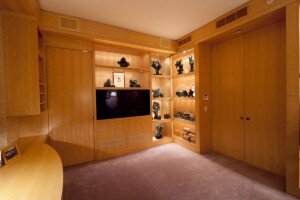Homework
Even if our school days are years away in the past, I’ll bet most of us still feel that beginning-of-the-year feeling in September. Autumn’s here and we’re settling back into our normal work habits. With the advance of technology, the 24/7 mentality, the growing number of home businesses starting up, working at home has become more commonplace. For some, it is our principal work place, for many others, we often have days when we work from home. I’ve been seeing more interest in home offices in recent years and I put together some thoughts based on two home offices I recently designed.
To start, the need to house technological elements definitely drives the layout of the space first. Some combination of phones, computers, videoconferencing, shredders, fax/scanner/printers, and televisions all have to go in. The space has to be highly organized so that all the elements are where they need to be, nearby and easily usable, with no mess of wires and electronics.
After that is taken care of, I like to make the room comfortable, creating an atmosphere conducive to productivity. Though it’s an office, why can’t it be an enjoyable and pleasant room? Comfortable armchairs or a sofa are a great asset if you decide to move from your desk while working, or meeting with colleagues or a client. Since these days the day is never done, having a place where you can think, dream, or problem-solve is more important than ever. Calming objects like a beautiful painting or objects that you love go a long way to reduce stress.
While the offices featured here are decidedly high end, the ideas in them can be incorporated into your own home or personal workplace. And why not? You work hard, you definitely deserve to treat yourself well!
Whether you are working with a designer, or doing it yourself, here are a few tips to make sure you’re taking care of the essentials.
What’s key in this article from my point of view as a designer:
THE IMPORTANCE OF A PROPER DESK OR TABLE FOR YOUR WORKSPACE.
A DUST-FREE ENVIRONMENT FOR ALL THOSE ELECTRONICS, WHICH MEANS MAKING THIS AN EASY-TO-KEEP CLEAN ROOM.
AND WHAT WIRES YOU DO HAVE: INVEST IN A SIMPLE CORD COVER.
Electronics
Make sure you have the proper power for whatever you need now and might add in the future. Do hire a licensed electrician to put in the right number of outlets and cable runs. Put in proper surge protectors, preferably with UPS (uninterrupted power source) system. It’s time to NOT do extension cords and have everything running off one outlet…what better way to lose your information in cyberspace? Not to mention fire hazard…
Furniture
This is a real office – it’s not an attic. Rather than put up with grandma’s hand-me-down sofa that has seen its day, it’s time to reupholster! But do check out the pricing. If this isn’t a sofa that is made well to start with (though being Grandma’s, it probably was) it’s probably less expensive to buy one. I advocate always buying a good product once, as it will last forever. If you choose to buy an inexpensive sofa, just know that it has a limited lifespan.
Light
Having your desk near a window is great. Light, light and more light is needed! Working in the dark not only strains the eyes, it can be depressing, and you don’t need that while trying to work. Just make sure you position the light so that it’s not reflecting in the computer screen.
Color
Some people find it soothing to have a neutral environment; others find lots of color uplifting. It doesn’t matter, as long as it’s right for you. Just make sure the neutral environment has lots of texture so it’s not boring, and if you choose lots of color don’t go overboard. Think about how it looks if you have clients, colleagues or customers over.
Storage
Ok, I’m one who likes to have my current work visible, but that doesn’t have to mean stacks upon stacks all over your desk and floor. Open filing systems that roll are great for those of us who have to see our files. Otherwise, make sure you have good shelving and enough filing drawers to handle your needs.
To do this, just measure what you have and translate that into lineal feet, and that will tell you what you need. For example, you have file folders sitting on the floor. Take a tape measure and measure them. Say they measure three feet and you have ten piles; you need 30 feet of file space. Don’t forget to buy or create extra space for new files! If you don’t have “growth” room, then be diligent about putting files in boxes and storing them off site. As I have project files from 30 years ago, I must keep my files. They are stored off site but are easily accessible when my clients call and need some information on some material found years ago! This works for books too.
Art and objects
Just find something that you love that removes stress when you look at it, even just for a moment. Maybe a souvenir from your travels that can really take you away! And here’s my take on buying art: buy with your eyes, not your pocketbook or with someone else’s opinion. Please please don’t buy something to “match” your décor. I have a client who collected museum posters from his travels; he loved them, we framed them beautifully, and they look great in his apartment! A good framing job is essential.
I could go on and on about art and how to install, place and pick, but maybe that’s another blog!



